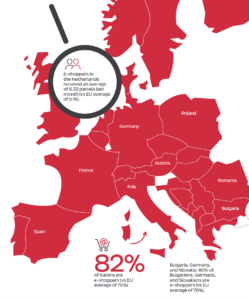In 2023, European online shoppers are returning to fundamental criteria when making purchases, as indicated by the Geopost e-shopper barometer.
Key factors influencing their choices include price, clarity of product features, ease of purchase and return, punctuality, and delivery flexibility. These findings underline the continued success of out-of-home delivery and consumer-to-consumer (C2C) platforms, aligning with observed trends over recent years. Despite the focus on these essential aspects of online shopping, emerging trends like increased use of social networks for inspiration and information are also acknowledged.
Frequent e-shoppers in the Netherlands received an average of 6.52 parcels last month (vs EU average of 5.16). Overall, the dynamics 2023 suggest a stabilization of business trends, with a slight erosion in the total number of online shoppers and a consistent proportion of regular e-shoppers.

E-commerce is here to stay
Carmen Cureu, Group Market Research Director at Geopost, provides insights into these findings: “With a robust methodology involving over 24,000 interviews across 22 countries, the 2023 edition of the Geopost e-shopper barometer indicates a clear sentiment: European regular e-shoppers remain deeply committed to e-commerce. In a challenging economic environment, online shopping is increasingly perceived as a means to save money, with consumers reverting to the basics of successful purchases: price, clarity, ease of purchase and returns, punctuality, and delivery. Based on these insights, the Geopost e-shopper barometer serves as a strategic compass for an industry navigating an ever-evolving landscape.”
Key Takeaways from the 2023 E-shopper Barometer
- E-commerce habits are ingrained, even in the face of economic challenges. Consumers have embraced the convenience and affordability of e-commerce, extending beyond non-essential goods to everyday essentials like food and health products. However, economic uncertainties prompt e-shoppers to balance convenience and price while ensuring access to essential items.
- E-commerce is slightly adjusting in 2023. The share of European e-shoppers has decreased slightly over the past two years, while the share of regular e-shoppers remains stable. Despite economic challenges, regular e-shoppers view e-commerce as a way to reduce the stress of offline shopping and save time.
- Regular e-shoppers prioritize price sensitivity; 65 percent of regular e-shoppers see online shopping as a way to save money. While eco-friendly deliveries remain important, there is a decreased willingness to pay a premium for green products in 2023.
- Out-of-home delivery gains momentum. Parcel shops and lockers will be used more in 2023, surpassing home delivery in popularity. Regular e-shoppers are shifting towards alternative delivery points, according to Geopost. With 44 percent choosing this option, European e-shoppers increasingly favor out-of-home delivery. Proximity, flexibility, and cost-effectiveness define OOH delivery, aligning with user preferences for convenience and savings.
- C2C platforms and social media play a crucial role. Seven out of ten regular e-shoppers buy or sell on C2C platforms, with a third increasing purchase of second-hand products. Social media is widely used for shopping, with inspiration and information being the primary reasons for usage.
- Perceptions of online shopping and delivery stabilize. After two years of decline, regular e-shoppers’ perceptions of delivery effort and last online purchase effort stabilized in 2023. However, some dissatisfaction persists, mainly related to lack of product transparency, unavailability, and delivery delays. Familiarity with the delivery company remains crucial, with regular e-shoppers preferring trusted providers.
Source: Geopost





